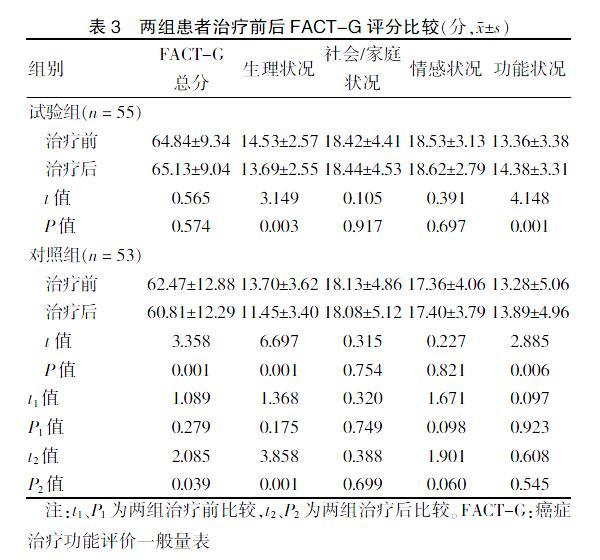经皮穴位电刺激治疗化疗后癌因性疲乏的临床效果
2020-05-25李艳张海波刘译鸿张馥丽胡利敏刘焕仪袁莉李海旭
李艳 张海波 刘译鸿 张馥丽 胡利敏 刘焕仪 袁莉 李海旭



[摘要] 目的 探討经皮穴位电刺激治疗化疗后癌因性疲乏的临床效果。 方法 选取2018年10月~2019年6月于广东省中医院肿瘤科筛查符合标准的肿瘤患者116例,根据随机数字表法分为两组,每组各58例,研究脱落8例,最终对照组53例,试验组55例。对照组按肿瘤科常规诊疗护理,试验组在此基础上加用经皮穴位电刺激,选取中脘、气海、关元、双侧内关、双侧足三里和双侧三阴交穴,于化疗期间及化疗前后实施,20 min/次,1次/d,共治疗5 d。两组均治疗5 d,治疗前后采用Piper疲乏修订量表评分、癌症治疗功能评价一般量表(FACT-G)评分评价患者的疲乏状态和生活质量。 结果 两组治疗后Piper疲乏修订量表整体及各维度评分比较,差异有统计学意义(P < 0.05)。对照组治疗后Piper疲乏修订量表整体及情感疲乏评分均高于治疗前,试验组治疗后Piper疲乏修订量表整体及各维度评分均低于治疗前,差异有统计学意义(P < 0.05)。两组治疗后FACT-G总分及生理状况评分比较,差异有统计学意义(P < 0.05)。试验组治疗后生理状况评分低于治疗前,功能状况评分高于治疗前;对照组治疗后FACT-G总分、生理状况评分均低于治疗前,功能状况评分高于治疗前,差异有统计学意义(P < 0.05)。结论 经皮穴位电刺激可缓解肿瘤患者的化疗后癌因性疲乏,并可改善肿瘤患者化疗后的生活质量。
[关键词] 癌因性疲乏;化疗;经皮穴位电刺激;生活质量
[中图分类号] R273 [文献标识码] A [文章编号] 1673-7210(2020)04(c)-0149-05
Clinical effect of transcutaneous electric acupoint stimulation in the treatment of cancer-related fatigue after chemotherapy
LI Yan ZHANG Haibo LIU Yihong ZHANG Fuli HU Limin LIU Huanyi YUAN Li LI Haixu
Department of Oncology, Guangdong Provincial Hospital of Traditional Chinese Medicine, Guangdong Province, Guangzhou 510120, China
[Abstract] Objective To investigate clinical effect of transcutaneous electric acupoint stimulation in the treatment of patients with cancer-related fatigue after chemotherapy. Methods Randomized study was used. From October 2018 to June 2019, 116 cancer patients who met the standard were screened in Oncology Department of Guangdong Provincial Hospital of Traditional Chinese Medicine. According to the random number table method, they were divided into two groups, with 58 cases in each group, 8 cases of abscission in each group, 53 cases in final control group and 55 cases in final experimental group. Control group was given routine diagnosis and treatment nursing in Oncology Department, On this basis, experimental group was treated with transcutaneous acupoint electrical stimulation. zhōngw?觍n, qìh?觍i, gu?觀nyu?觃n, bilateral neìgu?觀n, bilateral zús?觀nlǐ and bilateral s?觀nyīnji?觀o acupoints were selected. They were treated during and before chemotherapy, 20 minutes one time, once a day, for 5 days. Treatment period of two groups was 5 days. The fatigue state and quality of life of the patients were evaluated by Piper fatigue revised scale and functional assessment of cancer therapy-general (FACT-G) scale before and after treatment. Results There were significant differences between two groups in scores of overall and all dimensions of Piper fatigue revised scale after treatment (P < 0.05). In control group, overall scores and emotional fatigue score of Piper fatigue revised scale after treatment were higher than those before treatment, and in experimental group, overall score and all dimensions scores of Piper fatigue revised scale after treatment were lower than those before treatment, the differences were statistically significant (P < 0.05). There were significant differences between two groups in total scores of FACT-G and physiological status scores after treatment (P < 0.05). In experimental group, the score of physiological condition was lower than that before treatment, and the score of functional condition was higher than that before treatment; total score of FACT-G and the score of physiological status in control group were lower than those before treatment, and the score of functional status was higher than that before treatment, the differences were statistically significant (P < 0.05). Conclusion Transcutaneous electric acupoint stimulation can alleviate cancer-related fatigue and improve the quality of life of tumor patients after chemotherapy.
2.2 两组患者治疗前后FACT-G评分比较
两组治疗前FACT-G总分及各维度评分比较,差异无统计学意义(P > 0.05)。试验组治疗后生理状况评分低于治疗前,功能状况评分高于治疗前;对照组治療后FACT-G总分、生理状况评分均低于治疗前,功能状况评分高于治疗前,差异有统计学意义(P < 0.05)。试验组治疗后FACT-G总分及生理状况评分明显高于对照组,差异有统计学意义(P < 0.05)。见表3。
表3 两组患者治疗前后FACT-G评分比较(分,x±s)
注:t1、P1为两组治疗前比较,t2、P2为两组治疗后比较。FACT-G:癌症治疗功能评价一般量表
3 讨论
CRF是肿瘤患者普遍存在的症状之一,其发病机制尚未明确。在癌症幸存者中,疲乏可在治疗结束后的数月至数年持续存在;对于正在接受抗肿瘤治疗的患者来说,CRF的比例则更高[10],据统计,78%~86%接受全身化疗的肿瘤患者存在CRF[11-17]。在CRF的非药物疗法中,针刺[18]、穴位按摩[19]、瑜伽[20]的积极作用被不断证实,但TEAS治疗CRF却鲜见报道。TEAS是一种基于经皮神经电刺激的治疗方法,系将电极的使用引入到传统针刺疗法中,以刺激特定穴位,缓解症状,促进康复。本研究主要观察TEAS治疗肿瘤患者化疗后癌因性疲乏的效果,客观评估治疗前后Piper疲乏评分及FACT-G生活质量评分的变化。
本研究结果显示,TEAS能改善肿瘤患者化疗后的疲劳状态,提高患者生活质量。传统医学文献中并未有“癌因性疲乏”这一病名,但根据其病因病机和临床表现,可将其归属于中医“虚劳”范畴。胡彩琼[21]将其病因归纳为与先天禀赋不足、后天失养、情志郁结、大病久病及药毒攻伐有关;苏雅[22]认为其主要病机为气血阴阳不足,五脏亏损,因此针对“虚劳”的治疗原则是补五脏俱虚,补气血阴阳,而脾和肾尤为重要,治疗上多选取具有补脾益气、补肾益精功效的穴位或中药。本研究所选组穴均为补虚穴位,具有健脾益气、补肾填精的作用,符合“虚则补之”及“固本培元”的思想[23]。其中足三里为培土生元的保健要穴,具有理脾胃、扶正益气之功;关元、气海为元气之海,具有培补全身元气的功效;中脘系手太阳与少阳、足阳明之会,除具有补气健脾作用外,还可调理气机;三阴交为肝脾肾三条经脉交汇处,具有调气机、益脾气、补肾精的作用。而内关穴具有宁心安神、理气止痛的功效,可治呕吐、呃逆等胃疾,能缓解化疗所致的恶心呕吐等消化道反应。以上诸穴合用,可起到健脾和胃、补肾益精、调节气血的功效。
疲乏是一种主观体验,很少是一种孤立的症状,最常见与其他症状如疼痛、睡眠障碍、情绪困扰等一起发生。美国国立综合癌症网络指南建议评估CRF的伴发症状,并积极处理可干预的影响因素,运动被证实能缓解肿瘤患者的疲乏,但指南中并未给出具体的运动方案,需要专业人员根据患者的具体情况制订个体化的运动方案,而值得注意的是,正在接受抗肿瘤治疗的患者对运动疗法的依从性较差[24]。本研究采用TEAS作为干预措施,无需针刺操作,具有无创伤、操作简便的优点,且避免了部分患者畏惧针刺的问题,依从性较高。本研究结果显示,TEAS可改善CRF患者的疲劳状态,从而减轻躯体症状,提高生活质量。TEAS可作为正在接受抗肿瘤治疗患者的CRF的辅助治疗手段,值得在临床上进一步推广应用。
本研究结果表明,经皮穴位电刺激可作为CRF的辅助治疗手段,但本研究仍存在以下不足:①研究发现,化疗次数越多,CRF越严重,但由于样本量有限,本研究未根据不同癌种、化疗方案、化疗周期等进行分层分析。②本研究主要结局指标为量表评分,缺乏更客观的评价指标,后续可进一步在此方面探讨。③观察周期短,TEAS治疗的效果与疗程长短的关系不明确。有待将来大样本量的随机对照试验进一步深入探讨。
[参考文献]
[1] NCCN Clinical Practice Guidelines in Oncology-Cancer-Related Fatigue(Version Ⅰ. 2017) [DB/OL]. http://www.nccn.org.
[2] Hofman M,Ryan JL,Figueroa-Moseley CD,et al. Cancer-related fatigue:the scale of the problem [J]. Oncologist,2007,12(Suppl 1):4-10.
[3] Henry DH,Viswanathan HN,Elkin EP,et al. Symptoms and treatment burden associated with cancer treatment:results from a cross-sectional national survey in the US [J]. Support Care Cancer,2008,16(7):791-801.
[4] He XR,Wang Q,Li PP. Acupuncture and moxibustion for cancer-related fatigue:a systematic review and meta-analysis [J]. Asian Pac J Cancer Prev,2013,14(5):3067-3074.
[5] 黄菲,赵焰.经皮穴位电刺激治疗癌因性疲乏的随机对照试验研究[J].中国康复医学杂志,2019,34(6):688-692.
[6] 孙秋子.简易式经皮穴位电刺激缓解肿瘤患者癌因性疲乏的效果[J].中华现代护理杂志,2011,17(29):3486-3488.
[7] 中国抗癌协会.新编常见恶性肿瘤诊治规范(合订本)[M].北京:中国协和医科大学出版社,1999:773.
[8] 薛秀娟,许翠萍,杨雪莹,等.癌因性疲乏测评工具及评价指标的研究进展[J].中华护理杂志,2012,47(9):859-861.
[9] 万崇华,孟琼,汤学良,等.癌症患者生命质量测定量表FACT-G中文版评介[J].实用肿瘤杂志,2006,21(1):77-80.
[10] Yeh MH,Chao CH,Koo M,et al. Association of traditional Chinese medicine body constitution and moderate-to-severe cancer-related fatigue in cancer patients [J]. Complement Ther Med,2019,43:44-48.
[11] Ancoli-Israel S,Liu L,Rissling M,et al. Sleep,fatigue,depression,and circadian activity rhythms in women with breast cancer before and after treatment:a 1-year longitudinal study [J]. Support Care Cancer,2014,22(9):2535-2545.
[12] 张红娟,许海荣,李巧梅,等.影响胃癌化疗期间患者癌性疲乏发生的危险因素分析及自我管理模式的干预效果研究[J].现代肿瘤医学,2019,27(23):4238-4242.
[13] 曹丹,杨薇,罗文燕,等.肺癌化疗患者癌因性疲乏的调查分析[J].解放军医药杂志,2018,30(9):16-19.
[14] 周洁琼,陈祥建.自我管理教育对女性结直肠癌患者围手术期癌因性疲乏及生命质量的影响分析[J].中国现代医生,2018,56(31):80-83,86.
[15] 刘旻,任中贤,姚丽萍,等.患者微信群结合奥马哈系统模式的延续护理对肺癌癌因性疲乏的影响[J].中国现代医生,2018,56(15):149-152.
[16] 李琼,涂朝勇.正念减压疗法对肝癌介入化疗栓塞患者癌因性疲乏和睡眠质量的改善作用[J].中国现代医生,2019,57(6):59-62.
[17] 叶华清.淋巴瘤化疗伴癌因性疲乏患者实施护理干预后的效果观察[J].中国医药科学,2018,8(19):115-117,196.
[18] Liao M,Xie Y,Yan J,et al. Effect of acupuncture at 3 anti-fatigue acupoints in the treatment of cancer-related fatigue in patients with cancer:protocol for a systematic review and meta-analysis of randomized controlled trials [J]. Medicine,2019,98(23):e15919.
[19] Arring NM,Barton DL,Brooks T,et al. Integrative therapies for cancer-related fatigue [J]. Cancer J,2019,25:349-356.
[20] Baydoun M,Barton DL,Peterson M,et al. Yoga for cancer-related fatigue in survivors of hematopoietic cell transplantation:a feasibility study [J]. J Pain Symptom Manage,2020,59(3):702-708.
[21] 胡彩瓊.经络热度感测-背俞穴疗法在癌因性疲劳中的临床研究[D].广州:广州中医药大学,2016.
[22] 苏雅.针刺补虚组穴治疗癌因性疲乏的临床研究[D].合肥:安徽中医药大学,2016.
[23] 罗梓萍,宋梦初,费亚平.足三里穴位注射治疗38例恶性肿瘤的临床观察[J].中国民间疗法,2017(10):22-23.
[24] Nilsson M,Arving C,Thormodsen I,et al. Moderate-to-vigorous intensity physical activity is associated with modified fatigue during and after cancer treatment [J]. Support Care Cancer,2019. [Epub ahead of print].
(收稿日期:2019-11-26 本文编辑:李亚聪)
